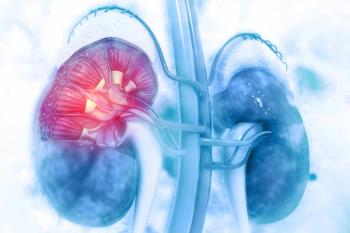
Bevacizumab/Everolimus Active in Certain Non–Clear Cell RCC Histologies
The combination of bevacizumab and everolimus had efficacy in patients with unclassified non–clear cell renal cell carcinoma characterized by papillary features, resulting in an objective response rate of 43%.
The combination of the VEGF-directed bevacizumab plus the mTOR-directed everolimus had efficacy in patients with unclassified non–clear cell renal cell carcinoma (nccRCC) characterized by papillary features, resulting in an objective response rate of 43%.
“Although the trial did not meet its primary endpoint, a striking signal was observed for defined histologic subgroups, specifically those with a significant papillary tumor component,” wrote researcher Martin H. Voss, MD, of Memorial Sloan Kettering Cancer Center (MSKCC), and colleagues in a study
Voss and colleagues conducted a single-center phase II trial testing everolimus 10 mg once daily plus bevacizumab 10 mg/kg every 2 weeks in 35 patients with treatment-naive nccRCC. The primary endpoint was progression-free survival at 6 months. The researchers also explored biomarkers using next-generation sequencing (NGS).
Patients in the trial had either unclassified (n = 23), chromophobe (n = 5), papillary (n = 5), or medullary (n = 2) RCC. Looking at the 34 evaluable patients, the median progression-free survival was 11 months; the median overall survival was 18.5 months, and the objective response rate was 29%.
The researchers found that progression-free survival varied by disease histology. Specifically, those patients whose disease had significant papillary or chromophobe features had higher objective response rates compared with other histologies.
Those patients with papillary features, including patients with unclassified disease, had an objective response rate of 43% compared with 11% among patients without these features. The median progression-free survival was 12.9 months compared with 1.9 months and the overall survival was 28.2 months compared with 9.3 months (P < .001).
“We compared baseline clinical features that could account for such discrepancies in outcome, including extent of disease, nephrectomy status, and MSKCC and International Metastatic Renal Cell Carcinoma Database Consortium risk status, but found no significant difference between the two subgroups,” the researchers wrote. “Our NGS analysis, although limited by sample size, yielded a number of thought-provoking findings.”
The researchers performed NGS for 28 patients with archival tissue. They found somatic mutations in ARID1A in 5 of 14 patients with papillary features, but none were identified in the other RCC variants. All the patients with ARID1A achieved the primary endpoint of 6-month progression-free survival.
“Altogether, the data suggest that ARID1A merits further study for its functional role in papillary RCC variants and as a candidate biomarker for future study of everolimus plus bevacizumab,” the researchers wrote.
Newsletter
Stay up to date on recent advances in the multidisciplinary approach to cancer.





